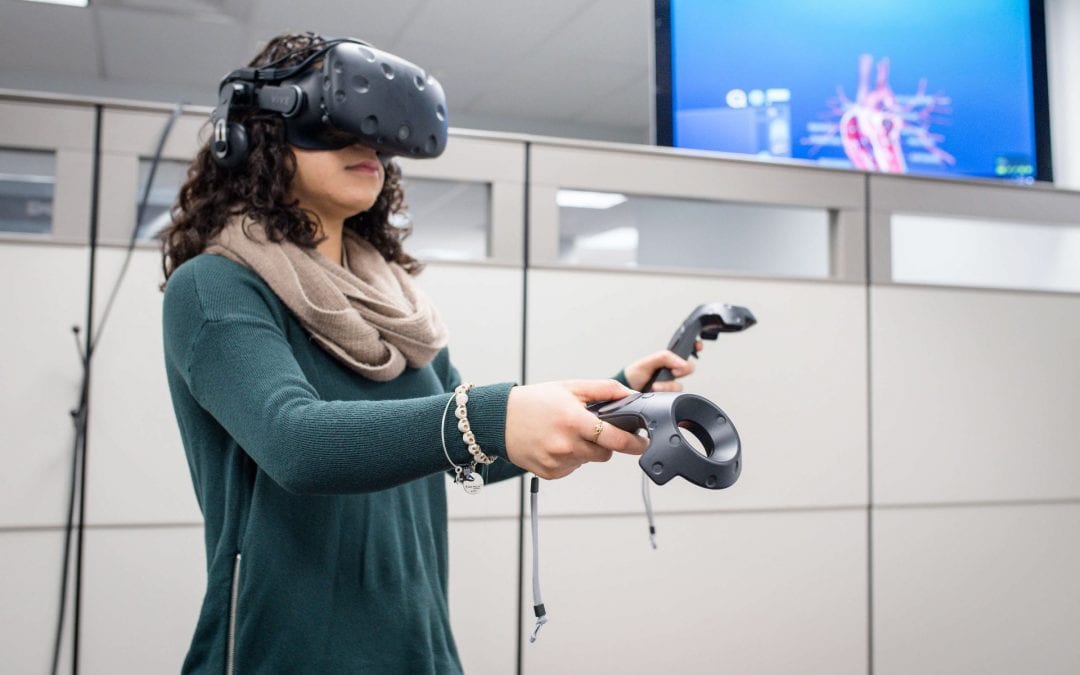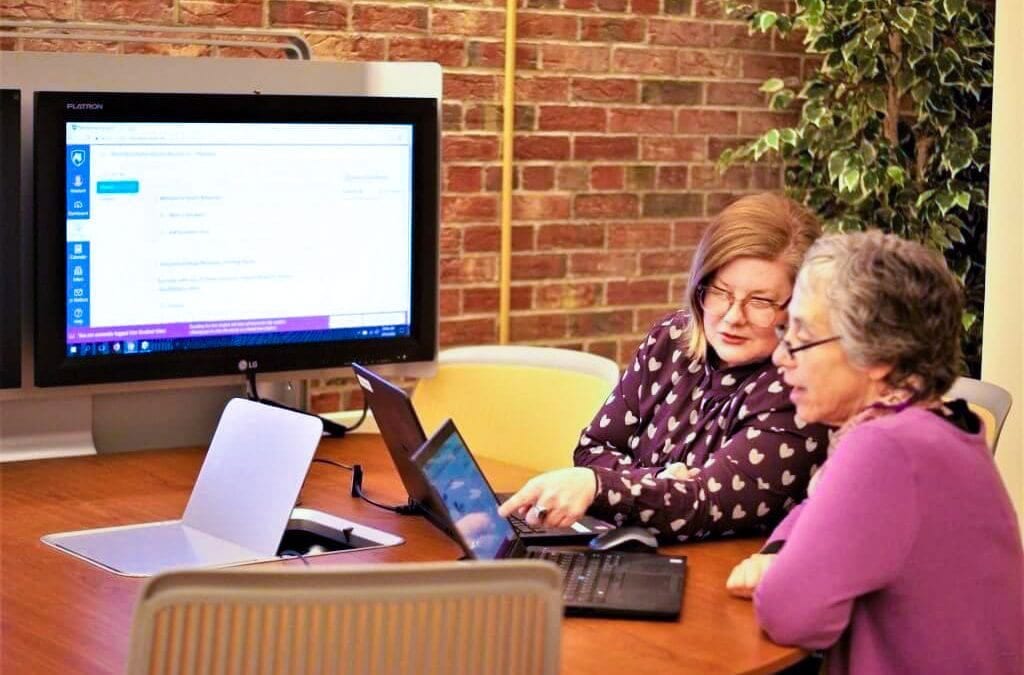
Examining the anatomy of an innovative internship
How one Penn Stater used immersive technology to deepen her passion for sharing knowledge
University Park, Pa. – What if someone told you that a nondescript building nestled in the northeast corner of Penn State’s University Park campus housed technology powerful enough to transform education? Would you come up with a plan to use those tools in a way that none of your peers previously had?
The Dreamery – located on the ground floor of Shields Building – houses immersive experience technology – such as 360° video and augmented reality – that allows faculty and students to explore its ability to change the way teaching and learning happen. One Penn Stater, upon being introduced to the Dreamery, realized its potential to put her zeal for teaching into practice in a revolutionary way.
Spenta Bamji, who recently received her bachelor’s degree in kinesiology this past May, said, “I always had a passion for sharing my knowledge with others to help them grow. My first teaching experience was as a dance teacher during high school, and since I’ve taught four-year-olds to 60-year-olds.”
During her final semester as an undergraduate, Bamji embarked on a teaching experience that no one at University Park, neither faculty nor student, had before her. She utilized virtual reality technology, guidance from faculty in the College of Education and staff from Teaching and Learning with Technology (TLT), and her own teaching experience to craft an internship at the Dreamery that demonstrated how VR can enhance anatomy and physiology education.
Bamji’s experience as a teaching assistant at Penn State cemented her interest in anatomy and physiology education as a career option. The seed for her work in VR, however, was planted by footage she found on sites that many people use to simply pass the time.
“I thought back to virtual reality videos I saw on social media and realized, ‘How cool would it be if I could incorporate that into a classroom setting,’” Bamji said.
The Dreamery is unlike a traditional classroom, and it provided the perfect setting for Bamji to discover how VR technology can impact the way anatomy and physiology are taught. Opened in December 2016, the Dreamery, a co-learning laboratory, is home to myriad technologies that can positively change the way teaching and learning happen. Every piece of furniture in the Dreamery is mobile which allows for almost unlimited configurations. A bank of 3D printers allows students to bring their designs to life. LittleBits give visitors a chance to try their hands at design thinking via rapid prototyping. And, of course, VR, augmented reality, and 360° video technology provide the immersive experiences.
Internships are an integral part of many undergraduates’ college education; the professional connections and real-world work experience often aid in making career decisions. Rarely, though, do students undertake the task of constructing an internship that didn’t previously exist for themselves. The distinctiveness of Bamji’s project made a particular impression on the head of Penn State’s kinesiology department – Dr. Nancy Williams.
“Experiences (like Spenta’s) help put students ‘at the top of the pile’ in my opinion, when it comes to next steps in their careers,” said Williams. “In a time when grade inflation renders such a large portion of students with high GPAs, these unique projects often foster students’ understanding of their own interests and aspirations.”
Williams played a key role in Bamji’s internship getting off the ground. The women met at a peer mentorship event for kinesiology majors in autumn 2017, and during their conversation, Bamji indicated her interest in researching immersive technology’s impact on anatomy and physiology education.
“Dr. Williams said, ‘Oh we have that here,’ and my first reaction was ‘Where?’ We were put in touch with TLT, I went down for my demo and it was awesome. I was at the Dreamery pretty much every day since,” Bamji said.
She also echoed Williams’ sentiment regarding taking her education into her own hands.
“People don’t realize just how many opportunities exist at Penn State. Within majors there are only so many emphasized career paths, so it’s important to take initiative, explore your major and realize Penn State offers so many chances to innovate. If, like me, that leads students down a different path than their peers then that’s great.”
With her opportunity, Bamji researched VR apps to determine which ones would best showcase the technology’s ability to enhance the teaching and learning of anatomy and physiology. She uncovered one that is “like a deeper level textbook” and another that provides users with a “full ‘Magic School Bus’ experience” where they get to travel inside organs such as hearts and lungs and observe them in various states. The remainder of her internship involved instructing faculty, students, and staff how to use the apps and demonstrating how they can be used in learning environments.
Dr. Chris Bopp, an assistant professor in the kinesiology department, worked with Bamji during a Science-U summer camp in 2017 and taught her in several of his courses. He got his first hands-on VR experience as part of her internship.
“I was blown away by my first experience with VR last semester. With the headset on I could move into the heart, look around and note anatomical structures and see the various parts of the heart working together with each beat. It was amazing,” he said.
Bopp added that Bamji’s work provided recommendations on programs he could use in his classes.
Traditional models of teaching anatomy and physiology include textbooks, plastic and clay models, and cadavers. They have been invaluable over the years, and fundamental to the educational development of healthcare providers at all levels. While new technology allows such vital subjects to be taught innovatively, Bamji believes the new techniques could supplement existing ones, not replace them.
“When I took functional anatomy, it was my first exposure to cadavers and it really helped me understand how the human body works. VR technology alone can’t match that experience, so we have to figure out how to best use new and current teaching methods alongside each other.”
Williams, who has decades of experience teaching and researching kinesiology topics, shares Bamji’s view that the two elements can join to create a well-rounded educational experience.
“There is nothing like the appreciation and understanding of human anatomy that comes from experiencing a real human cadaver. It also helps students develop respect for the wonder of the human body. Combined with technology that provides images and viewing angles that are otherwise impossible with cadavers, students get a holistic and comprehensive experience which improves learning.”
Bopp makes use of this approach by providing his Science-U campers with an opportunity to hold a human heart in their hands and examine its anatomical structures. Afterwards, the Dreamery’s VR systems allow them to observe those structures function and move.
When the fall semester begins, Bamji will take her unique internship with her as she works towards her master’s degree.
“I’m enrolling in a graduate program that can be geared specifically towards anatomy education, and it’ll go hand-in-hand with the work I’ve done with my internship. While I’m there I want to test other applications on the market, incorporate technology into classroom, lab, and library settings, and understand how students or faculty may benefit,” she noted.
Bamji added that a doctoral degree in anatomy or education may be in her future. Should she travel down that road and continue to study how VR impacts teaching and learning in those disciplines, Williams believes it would be well worth the effort.
“Kinesiology – the study of human movement – is by its nature dynamic and complex. Virtual reality and other technologies provide opportunities to test hypotheses and make observations that would be more difficult to address otherwise.”
